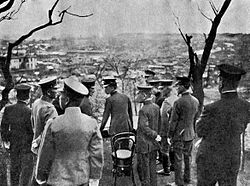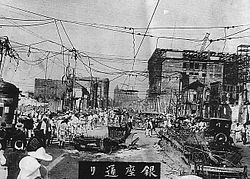Taishō period
| History of Japan |
|---|
 |
The Taishō period (大正時代, Taishō jidai), also known as the Taishō era, was a Japanese era name (年号,, nengō,, lit. "year name") after Meiji and before Shōwa.[1] This period started on July 30, 1912 and it ended on December 25, 1926. During this time, the emperor was Emperor Taishō-tennō (大正天皇).
The nengō Taishō means "Great Justice"[1] or "Great Righteousness".
Events of the Taishō period
The years in which Taishō was the Japanese monarch comprise this period or era.[2]
- 1920 (Taishō 9): First census of Japan, population 77 million[3]
- 1921 (Taishō 10): Prince Hirohito was made regent (sesshō)[1]
- 1923 (Taishō 12): Great Kantō earthquake;[1]
- 1925 (Taishō 14): The Emperor accepts the principle of the right to vote for everyone[1]
Politics
- 1912 (Taishō 1): Emperor Meiji died; and Saionji Kinmochi was the Prime Minister during the time of transition.[4]
- 1912 (Taishō 1): Katsura Tarō became 15th Prime Minister of Japan[5]
- 1913 (Taishō 2): Yamamoto Gonbee became 16th Prime Minister[6]
- 1914 (Taishō 3): Ōkuma Shigenobu became 17th Prime Minister[7]
- 1916 (Taishō 5): Terauchi Masatake became 18th Prime Minister[8]
- 1918 (Taishō 7): Hara Takashi became 19th Prime Minister[9]
- 1921 (Taishō 10): Takahashi Korekiyo became 20th Prime Minister[10]
- 1922 (Taishō 11): Katō Tomosaburō became 21st Prime Minister[11]
- 1923 (Taishō 12): Yamamoto became 22nd Prime Minister[12]
- 1924 (Taishō 13): Kiyoura Keigo became 23rd Prime Minister[13]
- 1924 (Taishō 13): Katō Takaaki became 24th Prime Minister[14]
- 1926 (Taishō 15):Wakatsuki Reijirō became 25th Prime Minister[15]
Gallery
Prince Regent Hirohito visits Yokohama after 1923 Great Kantō earthquake
The Ginza in Tokyo after 1923 earthquake
Taishō Period Media
- Emperor Taishō (cropped).jpg
Emperor Taishō in 1912
The Japan Times front page about the coronation of Emperor Taishō and Empress Teimei (15 September 1915)
- Empire-of-Japan-Topographic-Map-大日本帝国の地形図-1918.jpg
Map of the Empire of Japan in November 1918
- Khabarovsk intervention.jpg
Japanese occupation of the Russian city of Khabarovsk during the Russian Civil War, 1919
- Old-Marunouchi-Street-Tokyo-1920.png
1920 photo with a view of the Mitsubishi headquarters in Marunouchi, looking towards the Imperial Palace
Kōfu city hall in 1918 (Taishō 7)
Related pages
References
- ↑ 1.0 1.1 1.2 1.3 1.4 Nussbaum, Louis-Frédéric (2002). Japan Encyclopedia. Harvard University Press. p. 929. ISBN 978-0-674-01753-5.
- ↑ GlobalSecurity.org, Japanese years. Retrieved 2012-12-15.
- ↑ "First Census of the Japanese Empire Gives Its Total Population as 77,005,112," The New York Times. March 2, 1921. Retrieved 2011-12-15.
- ↑ Nussbaum, Louis-Frédéric (2002). Japan Encyclopedia. Harvard University Press. p. 808. ISBN 978-0-674-01753-5.
- ↑ Nussbaum, Louis-Frédéric (2002). Japan Encyclopedia. Harvard University Press. p. 494. ISBN 978-0-674-01753-5.
- ↑ Nussbaum, Louis-Frédéric (2002). Japan Encyclopedia. Harvard University Press. p. 1042. ISBN 978-0-674-01753-5.
- ↑ Nussbaum, Louis-Frédéric (2002). Japan Encyclopedia. Harvard University Press. p. 748. ISBN 978-0-674-01753-5.
- ↑ Nussbaum, Louis-Frédéric (2002). Japan Encyclopedia. Harvard University Press. p. 964. ISBN 978-0-674-01753-5.
- ↑ Nussbaum, Louis-Frédéric (2002). Japan Encyclopedia. Harvard University Press. p. 289. ISBN 978-0-674-01753-5.
- ↑ Nussbaum, Louis-Frédéric (2002). Japan Encyclopedia. Harvard University Press. p. 932. ISBN 978-0-674-01753-5.
- ↑ Nussbaum, Louis-Frédéric (2002). Japan Encyclopedia. Harvard University Press. p. 493. ISBN 978-0-674-01753-5.
- ↑ Prime Minister of Japan and Cabinet (Kantei), 1st-30th (1885-1934). Retrieved 2011-12-15.
- ↑ Nussbaum, Louis-Frédéric (2002). Japan Encyclopedia. Harvard University Press. p. 534. ISBN 978-0-674-01753-5.
- ↑ Nussbaum, Louis-Frédéric (2002). Japan Encyclopedia. Harvard University Press. p. 492. ISBN 978-0-674-01753-5.
- ↑ Nussbaum, Louis-Frédéric (2002). Japan Encyclopedia. Harvard University Press. p. 1025. ISBN 978-0-674-01753-5.
Other websites
![]() Media related to Taishō era at Wikimedia Commons
Media related to Taishō era at Wikimedia Commons
- National Diet Library, "The Japanese Calendar" -- historical overview plus illustrative images from library's collection
| Taishō | 1st | 2nd | 3rd | 4th | 5th | 6th | 7th | 8th | 9th | 10th | 11th | 12th | 13th | 14th | 15th |
|---|---|---|---|---|---|---|---|---|---|---|---|---|---|---|---|
| 1912 | 1913 | 1914 | 1915 | 1916 | 1917 | 1918 | 1919 | 1920 | 1921 | 1922 | 1923 | 1924 | 1925 | 1926 |
| Preceded by: Meiji |
Era or nengō: Taishō |
Succeeded by: Shōwa |

